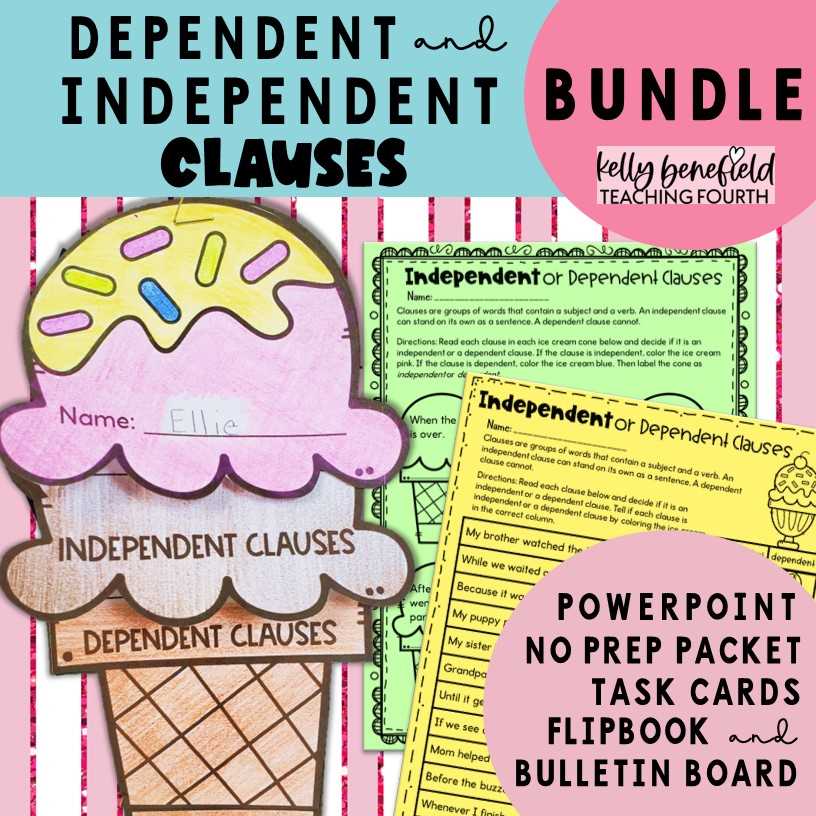
Teaching dependent and independent clauses in upper elementary does not have to be as tricky or difficult as you think.
When I first began teaching dependent and independent clauses, I struggled. I thought it would be difficult to help my students understand clauses and how they relate to complex sentences, but I soon realized that when students understand the components of a complex sentence (independent clauses and dependent clauses) they can grasp this tricky concept rather quickly. And, as I soon realized, teaching dependent and independent clauses does not have to be stressful or hard.

Learning how to write well is an essential skill that can lead to a lifetime of success, and writing is one of my favorite things to teach! I love seeing the transformation that fourth and fifth graders go through as they develop and become writers.
One of the most important components of good writing is understanding how clauses work. Mastering dependent and independent clauses can help your students improve their writing by helping them to learn about the components of complex sentences. Independent and dependent clauses are a building block, of sorts, to learning about and writing this type of sentence.
Understanding clauses and sentence structure is also beneficial to reading. When we take the time to teach sentence structure, we are also helping students to understand the predictable patterns of sentences which, in turn, helps them to make meaning of the text that they are reading.
An independent clause can stand on its own as a complete sentence, while a dependent clause cannot. Understanding the difference between these two types of clauses is essential for effective writing, but it can also be challenging, in the beginning, for students to grasp. Fortunately, there are many strategies and techniques that teachers can use to help their students master this important concept and become confident writers.
Help your students understand and use these clauses with these fun independent and dependent clauses ideas. Grab your students’ attention with these engaging activities.
One of the best ways that I have found to teach and introduce clauses is through modeling and practicing. I personally like to begin teaching dependent and independent clauses with a PowerPoint lesson that helps me provide explicit instruction, helps me to model, and provides examples as well as practice.
Dependent and Independent clauses can be somewhat tricky to understand, but understanding these clauses is a stepping stone for helping students identify and later write different types of sentence structures. Because of this, explicitly teaching clauses can help students grasp this tricky concept. Start by breaking down the difference between dependent and independent clauses and provide examples of each.
A PowerPoint can be a quick and simple way to introduce students to a new concept or skill. PowerPoints can be eye-catching and engaging, as well as interactive for students. They help visual learners absorb, organize, and internalize information. Teaching dependent and independent clauses with a PowerPoint lesson can provide explicit instruction, provide opportunities to model, and provide visual aesthetics that will help your student retain this new knowledge.

Important terms for students to understand when teaching dependent and independent clauses include:
Placing the information above into a PowerPoint lesson can enhance comprehension, retention, and recall of the material being taught. A PowerPoint, like the one above, can provide these key concepts for students, show examples of each, as well as provide fun and interactive practice of this new skill.
To further solidify students’ understanding of clauses, display posters or anchor charts of key terms and definitions. You can easily create your own hand-written anchor charts using the terms and definitions above and display them in a prominent place for students to use and refer to throughout the unit.
Then allow students to use the charts to help create a fun flipbook to write and record the meaning of each clause as well as examples. You can simply have students create a basic hotdog-styled flipbook, or create a fun-shaped flipbook like the one below.
Creating flipbooks can help both your visual learners as well as your kinesthetic learners. The act of writing and creating the flipbook can help these learners form a physical association. Plus, flipbooks are just fun!

Using task cards is great when practicing dependent and independent clauses, and there are many ways that these simple cards can be used when teaching dependent and independent clauses.
Task cards, like the ones below, help keep students from feeling overwhelmed and allow them to complete only one task at a time. When you use task cards in the classroom, they provide students with an interactive component. This offers students a tactile experience that cannot be achieved solely through conventional paper-and-pencil exercises. Using games such as “Scoot” allows students to practice the skill in a fun way and helps students remain engaged throughout the activity.

Practicing clauses may seem like a dry topic, but it does not have to be boring. With the help of fun worksheets filled with coloring activities, puzzles, and word searches, practicing dependent and independent clauses can become engaging and fun.
I love using interactive worksheets for student practice and informal assessment. They not only make learning about dependent and independent clauses more engaging but also help students retain the information.

Helping your students master clauses can be easier than you think, and the benefits of learning about clauses can benefit both your students writing and reading.
You may enjoy my Clauses Bundle. It contains all of the resources above for a discounted price. Check it out below.

And for even more ideas on teaching grammar, check out this blog post here.